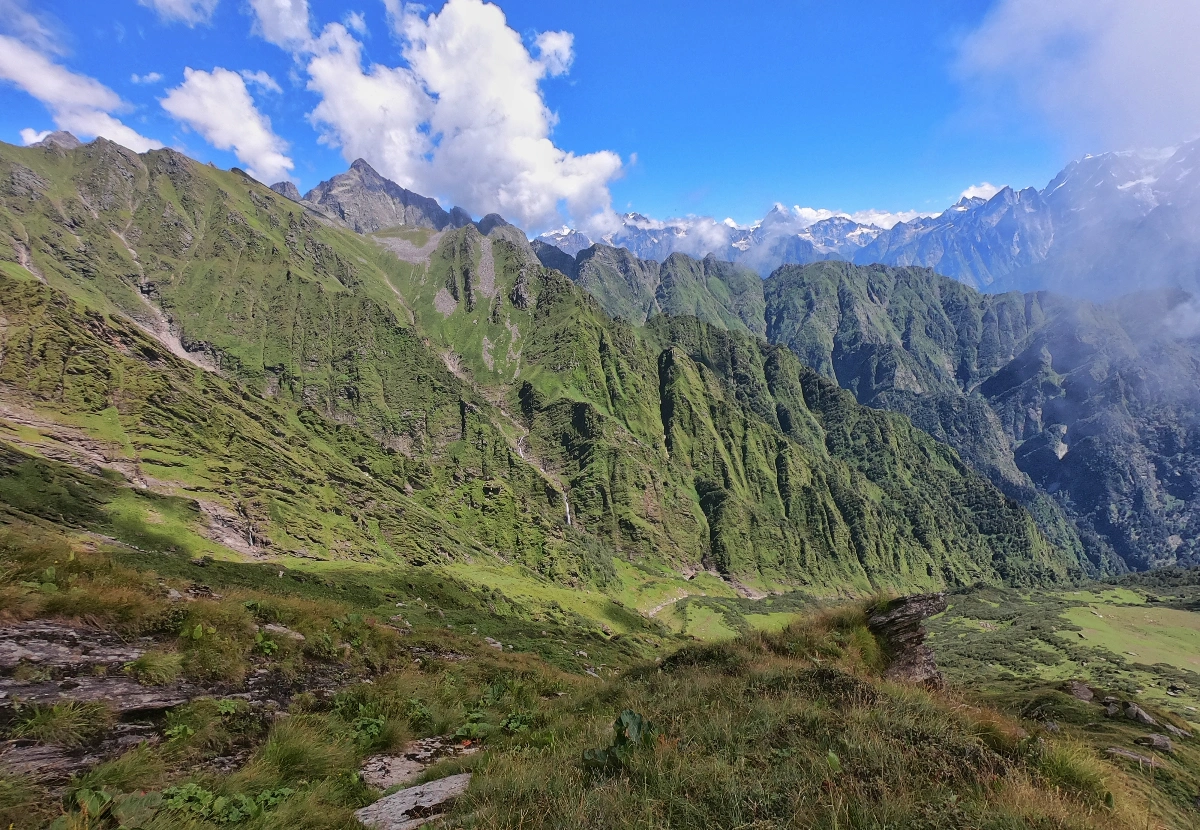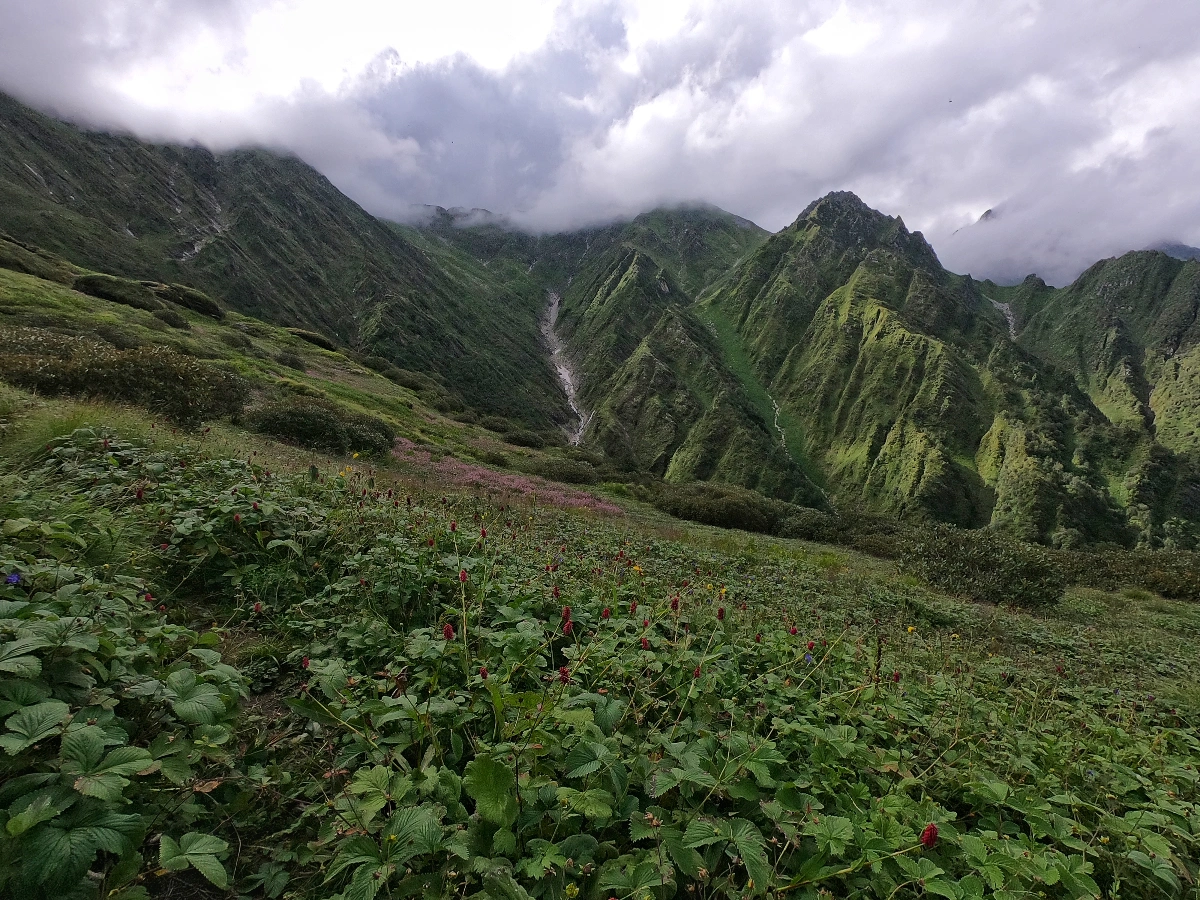Book your Valley of Flowers Trek package!!
5 NIGHTS/6DAYS
4329 Meters
Easy to Moderate
37 KM
June - Sep
20
The Valley of Flowers Trek is an incredible mix of nature, peacefully nestled in Uttarakhand’s West Himalayan area, and blessed with the unique and impressive Himalayan flora.
The Valley of Flowers Trek is a 17-kilometer round-trip trek that starts at Govindghat (1,830 m) and climbs through lush pine and birch forests, glacial streams, and waterfalls alongside the Pushpawati River before reaching a vibrantly colored high-altitude meadow at 3,658 m. The monsoon’s generosity has encouraged more than 500 species of alpine blooms—blue poppies, crimson primulas, golden potentillas, purple orchids, and hundreds of other wildflowers—to fully bloom against the backdrop of snow-clad Himalayan giants like Nilkantha and Kamet.
Until 1931, the presence of this awe-inspiring valley was unknown to the world. Three British mountaineers Frank S. Smythe, Eric Shipton, and R.L. Holdsworth while returning from an outstanding expedition of Mt. Kamet stumbled upon this fascinating valley full with blooming flowers. Captivated by the astonishing beauty of this place, they named it as the ‘Valley of Flowers’. Later on, Frank S. Smythe also wrote a book about this valley of flowers with the same title.
Many trekkers choose to extend their valley of flowers trek itinerary by adding a 6 km one-way side trip from Ghangaria (3,050 m) to Hemkund Sahib, a serene glacial lake and Sikh gurudwara situated at 4,329 m and encircled by seven towering peaks, transforming the botanical spectacle into a deeply spiritual pilgrimage that broadens the trek’s appeal to those seeking both natural wonders and sacred heritage.

Joshimath

Dehradun Railway Station

Dehradun

Jolly Grant Airport

(Summers-25° Max/ 10° Min) (Winters-18° Max/ -5° Min)

Joshimath: Jio/Airtel and VI Networks are available. During trek no networks are available.

Thaing Village is the last point that has electricity. Note: Most of the electricity is extremely intermittent and can be absent for most part of the day during winter/late summer (when monsoon starts to set in)

Srinagar, on the way to Joshimath has last ATM Note: Most of time ATM in hilly regions are not functioning.
Day 1: Dehradun to Joshimath
After arriving in Dehradun and enjoying a fulfilling breakfast, we will embark on our journey to Joshimath. This extensive drive will take us through the evening, passing the sacred confluences of the Ganga’s tributaries: Bhagirathi and Alaknanda at Devprayag; Mandakini and Alaknanda at Rudraprayag; Pinder and Alaknanda at Karnaprayag; and Dhauli Ganga and Alaknanda at Vishnuprayag. The route also features prominent locations like Rishikesh, Srinagar, and Dhaari Devi. Upon our arrival in Joshimath, we will check into our hotel for dinner and an overnight stay.
Day 2: Joshimath to Vishnuprayag to Thaing Village
Leaving Joshimath, we’ll proceed to Vishnuprayag, crossing the majestic Alaknanda River, which flows from Badrinath. After crossing the bridge at Vishnuprayag, our trek to the scenic Thaing Village begins. Nestled amid high mountain peaks, this remote village is steeped in local lore and legends. We’ll spend the night in tents, enjoying authentic local cuisine prepared by the villagers.
Day 3: Thaing Village to Dhar Kharak
An early start with breakfast will set us on our path to Dhar Kharak, visible from Thaing Village. Trekkers should carry ample water due to a scarcity along this stretch. Lunch will be served en route as we trek through dense forests and cross vibrant mountain streams. Upon reaching Dhar Kharak, we’ll dine and spend the night in tents.
Day 4: Dhar Kharart to Dharai-Rukh Dharra Valley
Today’s trek takes us from Dhar Kharak to Chenab Meadow in the flourishing Chenap Valley. Renowned for its ecological diversity, the valley is home to over 500 species of flowers and numerous medicinal and aromatic plants. We’ll spend the night in tents surrounded by this botanical paradise.
Day 5: Chenap Valley – Exploration Day
Dedicate this day to exploring the enchanting Chenap Valley. Immerse yourself in the breathtaking vistas, experiencing magical sunrises and sunsets that paint the snow-covered peaks in vibrant hues. The valley’s rich flora and fauna add to the day’s serenity and wonder.
Day 6: Chenap Valley to Thaing Village
After morning refreshments, we will take in the last breathtaking views of Chenap Valley as we trek back to Thaing Village. This evening, we reminisce about our journey as we prepare for our final night in the village.
Day 7: Thaing Village to Vishnuprayag to Joshimath
We will trek down to Vishnuprayag, where a vehicle awaits to return us to Joshimath for the night. This day provides a moment to rest and reflect on our expedition.
Day 8: Joshimath to Dehradun
We depart early from Joshimath, heading back to Dehradun. By evening, we conclude our memorable excursion, filled with stories, stunning photographs, new friendships, and joyful experiences from the Himalayas.
Basics Gears
Clothes
Accessories
Others
Mandatory Documents
Cancellation Policy
Refund Policy
The following refund shall be payable to the user in case of valid cancellation as per the guidelines
Note: The above-mentioned refunds are subjected to deductions for any expenses that may have been incurred for hotel booking or
transport etc. Refunds are applicable on the total cost and not on the advance amount.






No FAQ's Found For this Trek


Our goal is to encourage sustainable tourism in offbeat destinations of the Himalayas. We want more people to get out of the main trekking hubs & experience themselves and the planet on a new more meaningful level.
All Content & Photos Copyrighted by Mountainiax © 2025